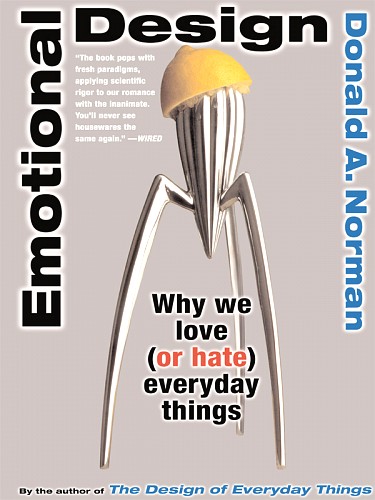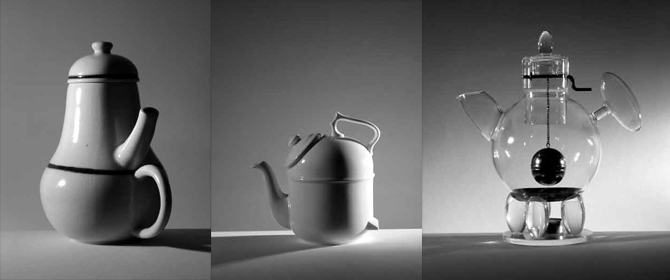Emotional Design by Donald A. Norman

I'm reading Emotional Design: Why We Love (or Hate) Everyday Things, a book by Donald A. Norman. I've been reading it for quite a while now, but have not gotten past the first chapter after reading the prologue every time I pick up the book. This time, I am documenting what I read in short summaries as I read in the hopes that it will motivate me to keep going. This weekend I read the first two chapters of the book and thought I'd share it, since it is part one of the book, so here is what the book is about thus far:
Part 1: The Meaning of Things
One: Attractive Things Work Better
Noam Tractinsky, an Israeli scientist conducted an experiment with ATMs that had different layouts of controls for ATMs. He found that ATMs with attractive displays seemed to work better for people. Prior to his experiment, two Japanese researchers, Masaaki Kurosu and Kaori Kashimura also conducted that experiment with Japanese users and had similar results. Tractinsky actually did not believe Israeli people would care about aesthetics and thought it may be a cultural thing with the Japanese, but contrary to his belief, the Israeli users actually were even more inclined to have better results with more beautiful ATM displays than the Japanese.
Here's an image of three different pots that all have a unique appeal that gives users pleasure when using them. The first pot is not practical as the handle is where the spout is. But it's interesting to look at and may make someone's day happy. The middle pot probably works the best functionality wise. The third one looks fragile and users may not use it for tea, but it may just be decorative.

Some people had thought that emotions were left over from animal origins, but it turns out human beings are the most emotional of all. Emotions are important to decision making and to our daily lives. For instance, being happy broadens our thought processes and lets us think more creatively. People are better at problem solving and brainstorming when they feel good. When people are anxious, they tend to narrow their thought processes.
Three Levels of Processing: Visceral, Behavioral, and Reflective
Visceral is the automatic, prewired layer. Behavioral is the part of the brain that controls everyday behavior. Reflective is the thinking part of the brain. Together they form parts of the total functioning of people. The three levels interact with one another.
Focus and Creativity
When stimulation is activated from the lowest level (visceral), it is called “bottom-up.” When the stimulation happens from highest level down it is called “top-down.” Bottom-up is driven by perception whereas top-down is driven by thought. Everything we do has meaning (cognitive) and value (affective). Value is always there, whether positive or negative, and it changes how we think.
When someone is happy, he/she is more creative and more able to overlook minor problems with the product being designed. Chances are, the product will be fun and enjoyable. When someone is anxious, he/she pays more attention to ensure all the details are in place and nothing is ambiguous. One is more focused when anxious and more creative when happy. One needs both in designing a product. Too much focus can result in failure to see obvious alternatives.
At the visceral level, people are pretty much the same, but at the behavioral and reflective levels, people are different in different cultures and age groups. These differences present design challenges, but these challenges should be seen as opportunities.
Two: The Multiple Faces of Emotion and Design
Sometimes our emotions or visceral level come in conflict with our reflective level. For instance when seeing a set of well-designed drawing tools, one may feel pleasure, but then upon thinking about how difficult it was to use the tools well, and the many mistakes that occurred when using them, can bring unpleasant memories.
Visceral design is about the initial impact of a design such as the appearance, touch, and feel. Performance is about how well the product does what it’s supposed to do. Usability is the ease in which the user can understand how the product works. The reflective level is where levels of feelings, emotions, and cognition reside. It’s here that the full impact of both thought and emotions are experienced.
Working with the Three Levels
- Visceral design > Appearance
- Behavioral design > The pleasure and effectiveness of use
- Reflective design > Self-image, personal satisfaction, memories
Designing for those three categories can be difficult. Should some products be mostly visceral, others behavioral, and others reflective? Doesn’t reflective design depend on the target group? No single product can satisfy everyone. Sometimes someone may not like something but they can learn to like it, such as bitter and sour tastes. Products that are marketed to everyone across the world can only succeed if there are no real alternatives or if they reposition their appeal to different people through advertising and marketing. Products such as Coca-Cola and Pepsi are such products with world-wide success. Many products specialize and cater to a specific audience, such as magazines. There are so many different kinds of magazines, each one catering to different people.
Objects that Evoke Memories
Long-lasting feelings take time to develop, and the surface appearance and behavioral side play relatively minor roles for objects that evoke those memories. Souvenirs for instance, may not look like works of art, but the memories they are associated with, with regards to the traveling, the vacation moments, are what give the objects value. Nobody likes kitsch since if too many people likes something, there must be something wrong with it. But, that doesn’t matter if the object itself is not admired, but the memories it is associated with is valued. We become attached to items if they have a significant personal association.
Feelings of Self
Our memories reflect our life experiences and remind us of people in our lives and experiences and accomplishments. They also reinforce how we view ourselves. We care about how we view ourselves and how others view ourselves. The way we dress, behave, the items we possess, jewelry, cars homes, are all public expressions of ourselves. The concept is deeply reflective, thus hard to deal with in design. It is culturally specific. The products you buy and your lifestyle both reflect and establish your self-image and the images others have of you. People like the sense of accomplishment from making something on their own. When it came to baking their own cake, they felt less enjoyment if all they needed to do was add water to the cake mix and bake. When they had to add an egg and add water, however, they felt more of a sense of accomplishment, even though, still, they weren’t baking the cake from scratch.
Personality of Products
Products and company brands have personality. Product personality reflects many decisions about how a product looks, behaves, and is positioned throughout marketing and advertisements. Terms such as fashion, style, mode, and vogue are used, though they demonstrate how fragile the reflective part of design is.
